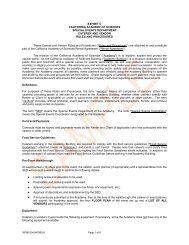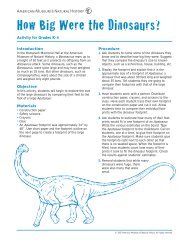Prior Knowledge Questionnaire - California Academy of Sciences
Prior Knowledge Questionnaire - California Academy of Sciences
Prior Knowledge Questionnaire - California Academy of Sciences
You also want an ePaper? Increase the reach of your titles
YUMPU automatically turns print PDFs into web optimized ePapers that Google loves.
<strong>California</strong> <strong>Academy</strong> <strong>of</strong> <strong>Sciences</strong><br />
Institute on Conservation Education & Sustainability<br />
<strong>Prior</strong> <strong>Knowledge</strong> <strong>Questionnaire</strong> (Session 1 Homework)<br />
Adapted from John Falk’s, Personal Dimensions <strong>of</strong> Learning Class, Oregon State University, 2010<br />
About the <strong>Questionnaire</strong>: In the backwards design process we start with trying to understand what<br />
visitors know about the topic that we are going to design an educational activity around. This can help<br />
us understand the audiences’ perspectives around the topic.<br />
What to do: After you’ve selected the topic, conduct 10-15 <strong>of</strong> the following interviews (or work with a<br />
group to get that many total). Try to get a diversity <strong>of</strong> people, preferably folks from different<br />
backgrounds and ages. You may interview a small group <strong>of</strong> people (2-4) at a time if they are all hanging<br />
out together.<br />
Notice: In addition to taking notes on the answers, notice how different people talk about the topic, and<br />
if the language they use matches up with the scientists language.<br />
Approach Someone: Smile, be friendly, make eye contact. If you are aiming this activity toward s a<br />
specific age group, make sure to ask those people (i.e. why interview adults if your activity will<br />
ultimately be delivered to school groups). If you want to hear from kids, interview the family together.<br />
Introduction: We’re doing some research as we plan a new activity, and are trying to figure out what<br />
people know about the topic, and what questions they have. Can you (and your family/ friends) spare a<br />
few minutes to help me out?<br />
1. What do you know about _____________? Do you consider yourself knowledgeable or not on<br />
this topic?<br />
2. How did you learn about it? From what source(s)?<br />
Continued on next page….<br />
Contact Lindzy Bivings (lbivings@calacademy.org) for more information<br />
1 | P age
<strong>California</strong> <strong>Academy</strong> <strong>of</strong> <strong>Sciences</strong><br />
Institute on Conservation Education & Sustainability<br />
3. Are you interested in this topic? Why or Why not?<br />
4. What questions do you have about it? Where would you go to find answers to your questions?<br />
(note: you do not have to answer the questions)<br />
5. Can you think <strong>of</strong> anything that would help address this issue?<br />
6. Demographics (collect for each person):<br />
Age: ____________<br />
Pr<strong>of</strong>ession: __________<br />
Gender: ______________<br />
Contact Lindzy Bivings (lbivings@calacademy.org) for more information<br />
2 | P age
<strong>California</strong> <strong>Academy</strong> <strong>of</strong> <strong>Sciences</strong><br />
Institute on Conservation Education & Sustainability<br />
How to Synthesize Information from <strong>Prior</strong> <strong>Knowledge</strong> Surveys<br />
(Session 2 Activity)<br />
This is for you, the educator to answer.<br />
How many people<br />
had never heard <strong>of</strong>,<br />
or were clueless<br />
about the issue?<br />
How many people had<br />
heard <strong>of</strong> the issue, but<br />
were somewhat<br />
unconfident or had<br />
some misinformation?<br />
How many people were<br />
confident in their<br />
knowledge about the<br />
issue?<br />
Other?<br />
Words Scientists Use (or ways <strong>of</strong> describing<br />
things in the articles)<br />
Words Laypersons Use<br />
Continued on next page….<br />
Contact Lindzy Bivings (lbivings@calacademy.org) for more information<br />
3 | P age
<strong>California</strong> <strong>Academy</strong> <strong>of</strong> <strong>Sciences</strong><br />
Institute on Conservation Education & Sustainability<br />
What other patterns did you notice?<br />
What other questions do you have?<br />
What do you think this means for you as an educator?<br />
Contact Lindzy Bivings (lbivings@calacademy.org) for more information<br />
4 | P age
<strong>California</strong> <strong>Academy</strong> <strong>of</strong> <strong>Sciences</strong><br />
Institute on Conservation Education & Sustainability<br />
Educator Action Planning Tool (Session 2 Activity)<br />
This is for you, the educator to answer.<br />
Though it may seem backwards, we begin with asking people about our ideas for planning a<br />
conservation action before we actually get too far into designing a whole education plan<br />
around it. The point <strong>of</strong> asking first is to avoid putting hours (or days or weeks) <strong>of</strong> time into<br />
designing something that people won’t even consider doing. To help ground the action in<br />
something that is impactful to an issue, read through the questions below, and then try to<br />
answer them.<br />
(1) What environmental issue do you wish to address?<br />
(2) Why do you think this important?<br />
(3) What might you ask people to do in order to address this issue? Put a star next to the things<br />
that you think will be most impactful. Or, put a question mark if you are not sure.<br />
Contact Lindzy Bivings (lbivings@calacademy.org) for more information<br />
5 | P age
<strong>California</strong> <strong>Academy</strong> <strong>of</strong> <strong>Sciences</strong><br />
Institute on Conservation Education & Sustainability<br />
Continued on next page….<br />
(4) Can you refine that idea into a “non-divisible” behavior, or “end-state” behavior (i.e. having<br />
someone do a home energy audit is not an end-state behavior, but having someone put<br />
insulation in their attic is)?<br />
(5) What do you think the barriers and benefits to this action/behavior are?<br />
When you’ve been able to ask these questions to your liking, input your action into the “Feasibility <strong>of</strong><br />
Actions <strong>Questionnaire</strong>” and conduct another set <strong>of</strong> interviews to see what your audience thinks <strong>of</strong> it.<br />
Contact Lindzy Bivings (lbivings@calacademy.org) for more information<br />
6 | P age
<strong>California</strong> <strong>Academy</strong> <strong>of</strong> <strong>Sciences</strong><br />
Institute on Conservation Education & Sustainability<br />
Feasibility <strong>of</strong> Actions <strong>Questionnaire</strong> (Session 2 Homework)<br />
Adapted from the Azjen’s Theory <strong>of</strong> Planned Behavior http://people.umass.edu/aizen/tpb.html<br />
Use this survey with the targeted visitors you wish to address, and make an ask <strong>of</strong>.<br />
Perceived Behavioral Outcomes<br />
(1) What do you see as the advantages/ benefits <strong>of</strong> doing _______________________?<br />
(2) What do you see as the disadvantages <strong>of</strong> your doing ______________________?<br />
(3) What else comes to mind when you think about doing ______________________?<br />
Personal Control Factors<br />
(1) In the past three months how <strong>of</strong>ten have you done ______________________, or something<br />
similar?<br />
Continued on next page….<br />
Contact Lindzy Bivings (lbivings@calacademy.org) for more information<br />
7 | P age
<strong>California</strong> <strong>Academy</strong> <strong>of</strong> <strong>Sciences</strong><br />
Institute on Conservation Education & Sustainability<br />
(2) What factors, circumstances, or tools would make it easy or enable you to _________________.<br />
(3) What factors or circumstances that would make it difficult or prevent you from doing<br />
______________________ .<br />
Social Norms & Personal References<br />
(1) Sometimes, when we are not sure what to do, we look to see what others are doing.<br />
What individuals or groups are most likely to do ______________________?<br />
(2) Who do you think are least likely to do ______________________?<br />
Contact Lindzy Bivings (lbivings@calacademy.org) for more information<br />
8 | P age
<strong>California</strong> <strong>Academy</strong> <strong>of</strong> <strong>Sciences</strong><br />
Institute on Conservation Education & Sustainability<br />
How to Synthesize Information from Feasibility <strong>Questionnaire</strong><br />
(Session 3)<br />
How many<br />
interviewees<br />
already do this?<br />
What benefits<br />
did they cite?<br />
What barriers<br />
did they site?<br />
What would help<br />
them do your<br />
action?<br />
What would<br />
prevent them<br />
from doing it?<br />
What other patterns did you notice?<br />
What other questions do you have?<br />
What do you think this means for you as an educator?<br />
Contact Lindzy Bivings (lbivings@calacademy.org) for more information<br />
9 | P age


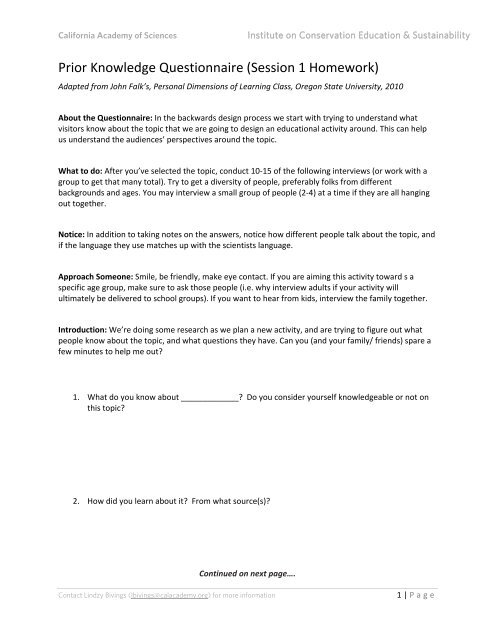
![download [PDF - 2.7mb] - California Academy of Sciences](https://img.yumpu.com/26596748/1/190x122/download-pdf-27mb-california-academy-of-sciences.jpg?quality=85)

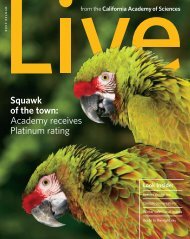

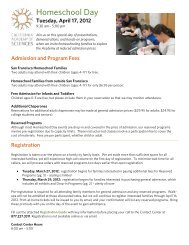
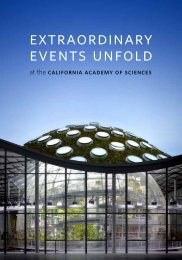
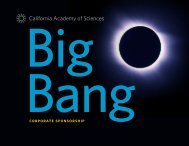
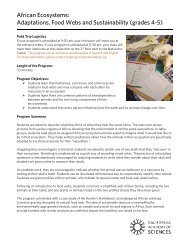
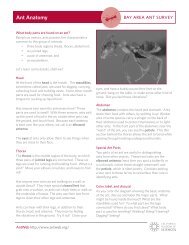
![Download a visitor map [418k] - California Academy of Sciences](https://img.yumpu.com/26596645/1/190x88/download-a-visitor-map-418k-california-academy-of-sciences.jpg?quality=85)
